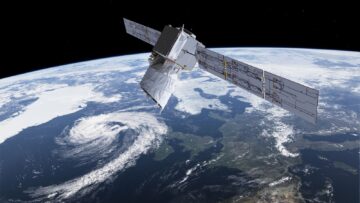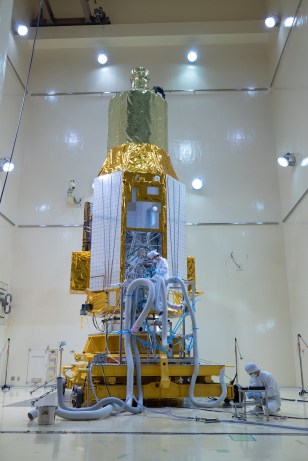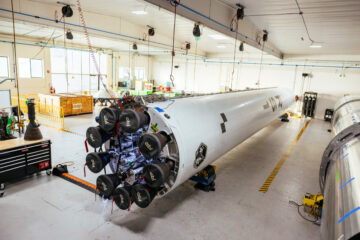
WASHINGTON — SpinLaunch, a company developing an alternative launch system that fires payloads at hypersonic speeds from a ground-based centrifuge, successfully fired its first projectile from a subscale version of its accelerator.
The test took place Oct. 22 at Spaceport America in New Mexico, where the company built a version of its accelerator 33 meters in diameter. That accelerator spun up a projectile three meters long, releasing it at high speeds into the skies.
“This was the first time we put all the pieces together,” Jonathan Yaney, chief executive of SpinLaunch, said in an interview. “It’s a really big moment for us.”
The centrifuge ran at 20% of its maximum power, he said. He declined to give specific details about the projectile’s flight, but said it flew at supersonic speeds and reached altitudes of “tens of thousands of feet.” The projectile was instrumented and collected data, but did not have any active controls, instead flying a ballistic trajectory.
The system was designed to test the overall concept behind SpinLaunch, which uses a centrifuge in a large vacuum chamber to accelerate a projectile, releasing it at hypersonic speeds. The accelerator serves as a first stage of a launch system, with the projectile carrying rocket engines that act as upper stages to place a payload into orbit.
The accelerator “performed amazingly” in the October test, he said. “It’s a really huge milestone and it’s validated all of our efforts.”
SpinLaunch is planning a series of 30 tests over the next six months of the suborbital system. “From here, we really just keep increasing power, and we’ll be putting more components and subsystems of our orbital launch vehicle into this launch system, which will allow us to validate ideas and try new things,” Yaney said.
Building the system in a remote location at the spaceport was difficult, he said. “Being an hour away from any kind of civilization and support certainly presented its own set of challenges,” he said, exacerbated by extreme weather conditions there. “We needed a location that was a combination of being affordable, gave us the freedom to move quickly, and had airspace that goes all the way to the edge of the atmosphere.”
He said the spaceport and the New Mexico state government was “incredibly supportive” of their activities. About half of SpinLaunch’s 200 employees are based in New Mexico, with the rest in its Long Beach, California, headquarters.
The company has been scouting coastal locations to build a larger version of the accelerator, about 100 meters across, needed for orbital launches. “We are in the late stages of finalizing our agreements on our launch site,” Yaney said, with an announcement planned “in short order.”
The design of that system will be finalized and construction beginning in the next year. That would set the company up to begin orbital launches in 2025, he said.
SpinLaunch has been working on other elements of the system besides the giant accelerator, such as the rocket engines that will serve as upper stages to place payloads weighing up to 200 kilograms into orbit. Those engines will be standard bipropellant designs, he said, but be “incredibly low-tech versions” with pressure-fed systems and few parts, intended to be built cheaply and in large quantities.
The company has also been testing how spacecraft components can high the high-g environment of the accelerator. “Very few people have experience designing mechanical and electronics systems to go into a high-g centripetal environment. It’s just a unique environment,” he said. “It’s been pretty surprising to learn how benign of an environment it is, and how not challenging the design effort turns out to be.”
The payoff for all that effort is a launch system the company believes can send payloads to space several times a day at costs far less than conventional rockets. “The rocket equation has always been this gating function on how inexpensively you can launch something into orbit,” Yaney said. “SpinLaunch sets out to disrupt that.”
SpinLaunch projects that, on a per-kilogram basis, the system will be less expensive than “incumbent large-scale launch vehicles” in service today, he said. “It will also be 10 to 20 times less expensive than the emerging small launch systems. We’ve developed a system that is very disruptive and very well-suited to launching the next generation of large-scale low Earth orbit satellite constellations.”
Seeing the system operate for the first time last month was “surreal,” he said. “There’s a tremendous feeling of accomplishment, almost disbelief and wonder, that we took something that the world had never seen before, this entirely brand-new technology, and birthed it into existence.”
- 100
- accelerator
- active
- activities
- agreements
- All
- america
- Announcement
- build
- california
- carrying
- chief
- company
- construction
- Costs
- data
- day
- Design
- DID
- Disrupt
- Edge
- Electronics
- employees
- Environment
- executive
- experience
- Feet
- First
- first time
- flight
- Freedom
- function
- Government
- here
- High
- How
- HTTPS
- huge
- Interview
- IT
- large
- launch
- launches
- LEARN
- location
- Long
- Mexico
- months
- move
- order
- Other
- People
- planning
- power
- projects
- REST
- satellite
- Series
- set
- Short
- SIX
- small
- Space
- spacecraft
- Stage
- State
- support
- system
- Systems
- Technology
- test
- Testing
- tests
- the world
- time
- us
- Vacuum
- vehicle
- world
- year










